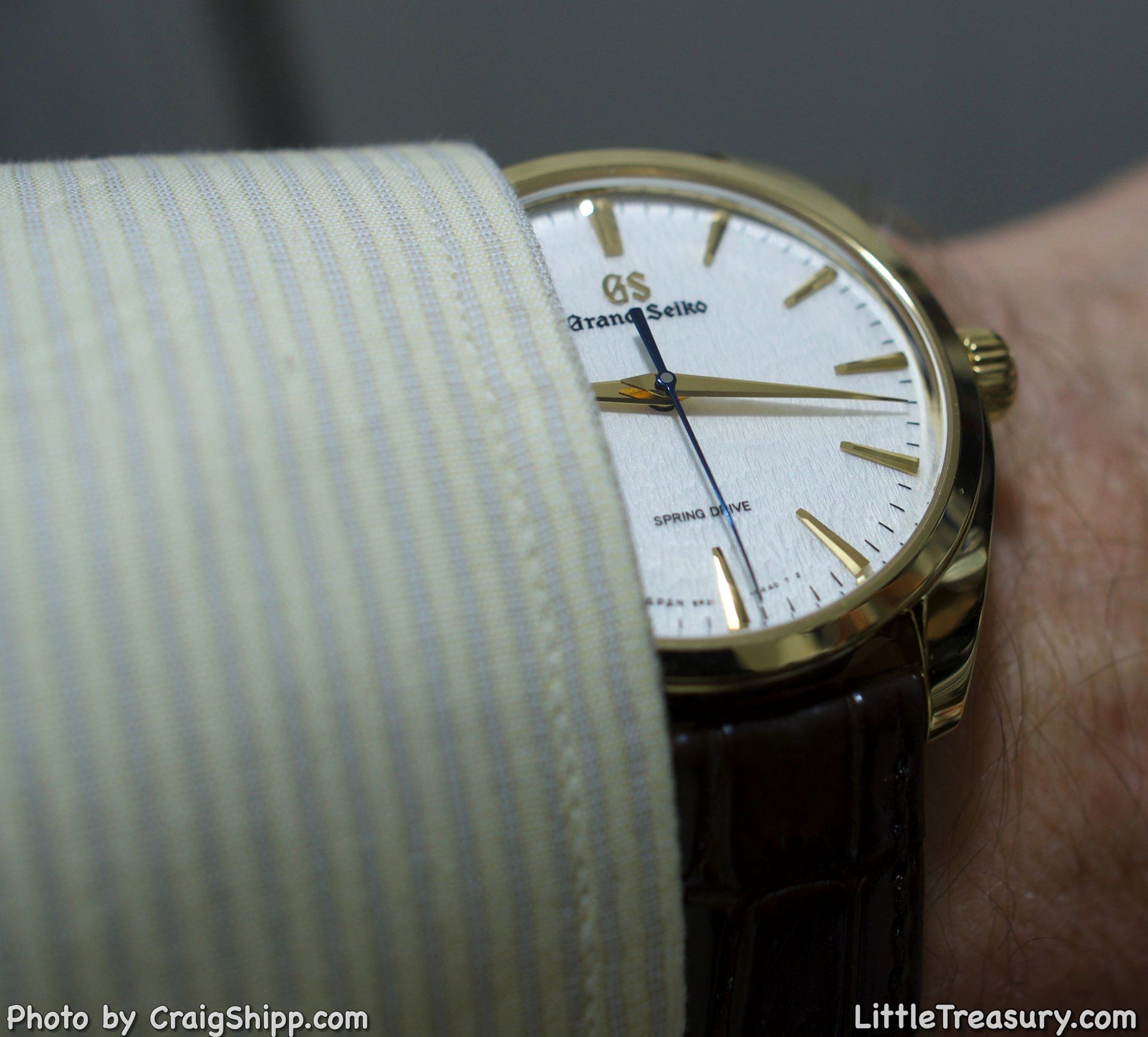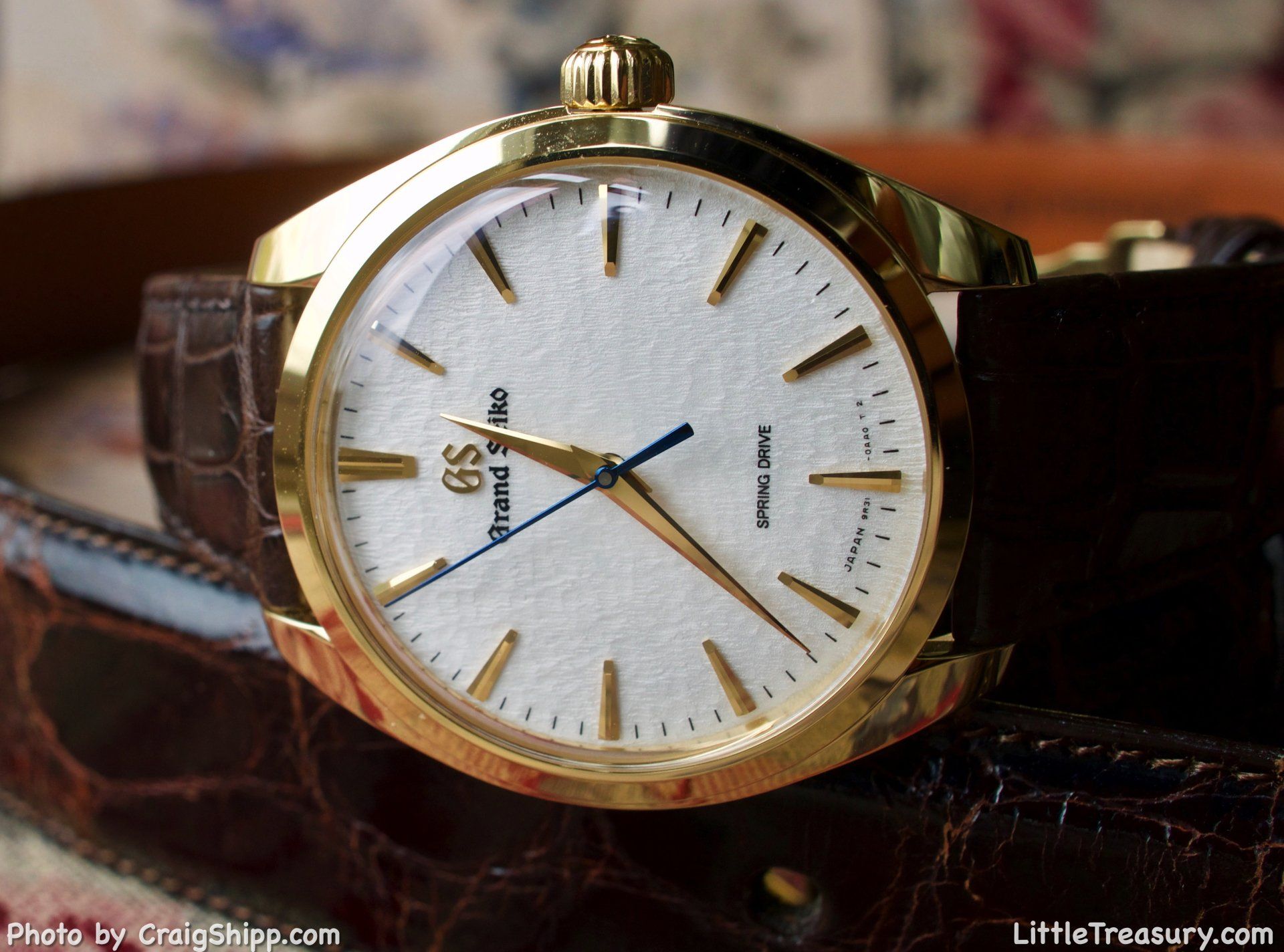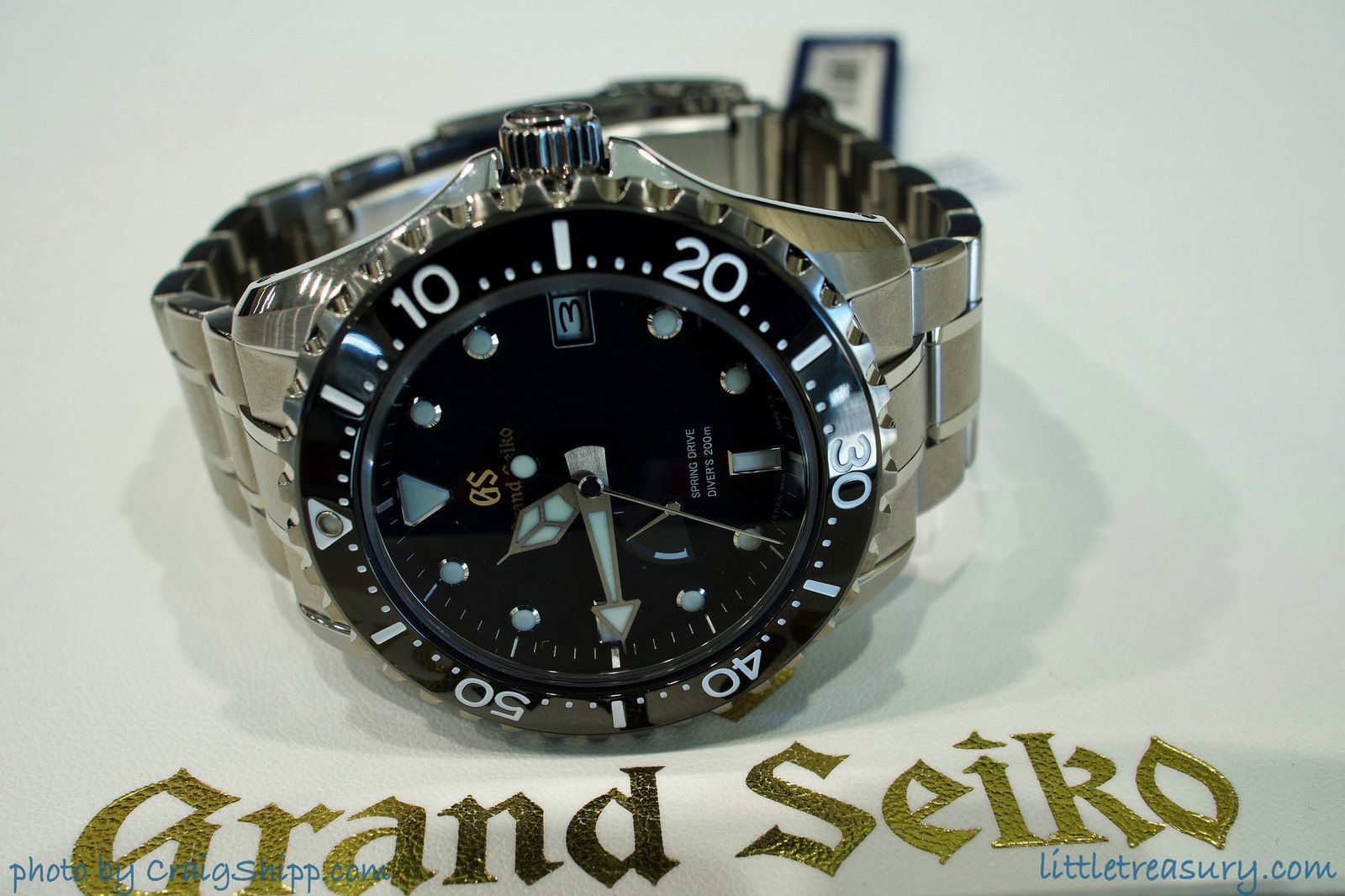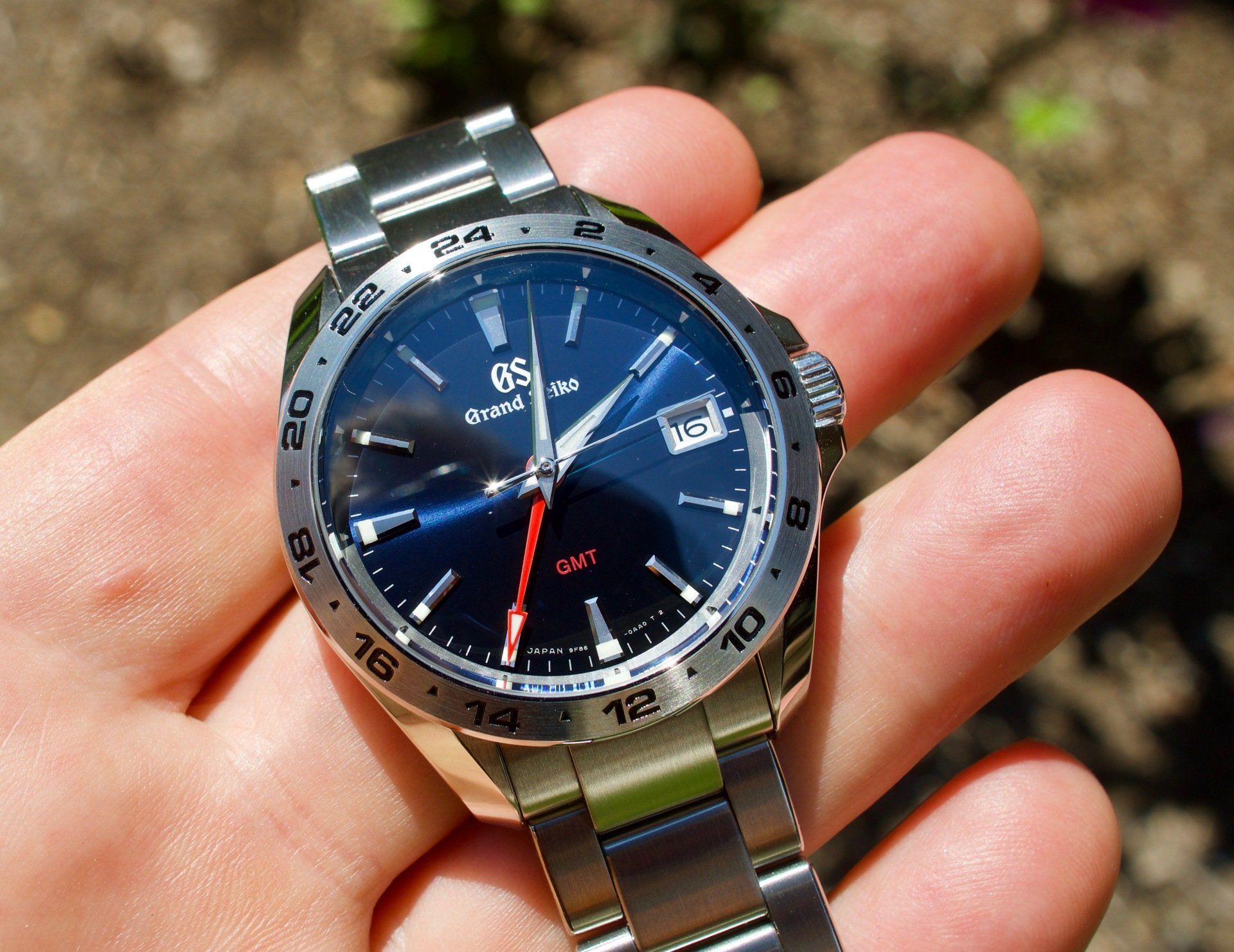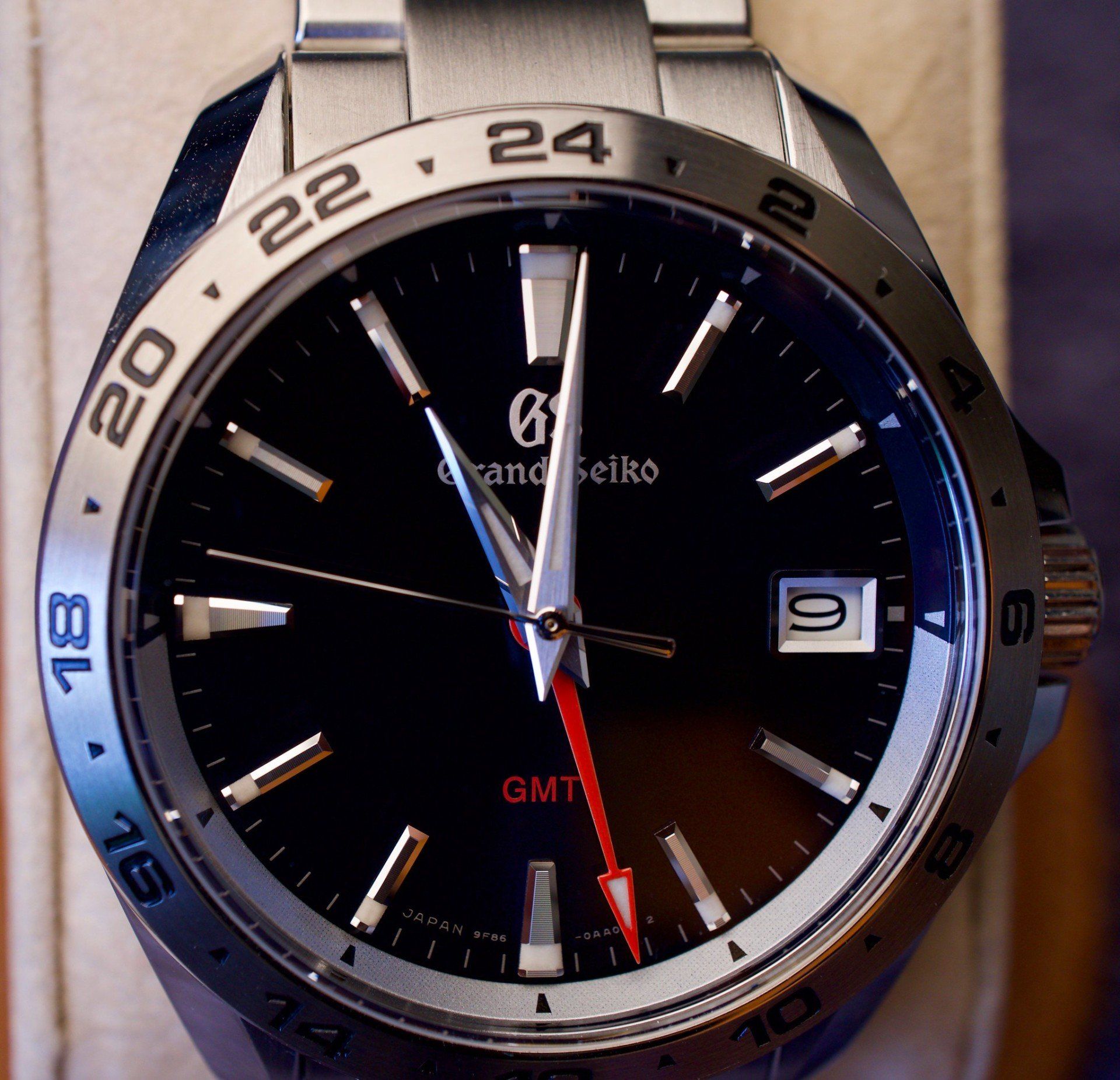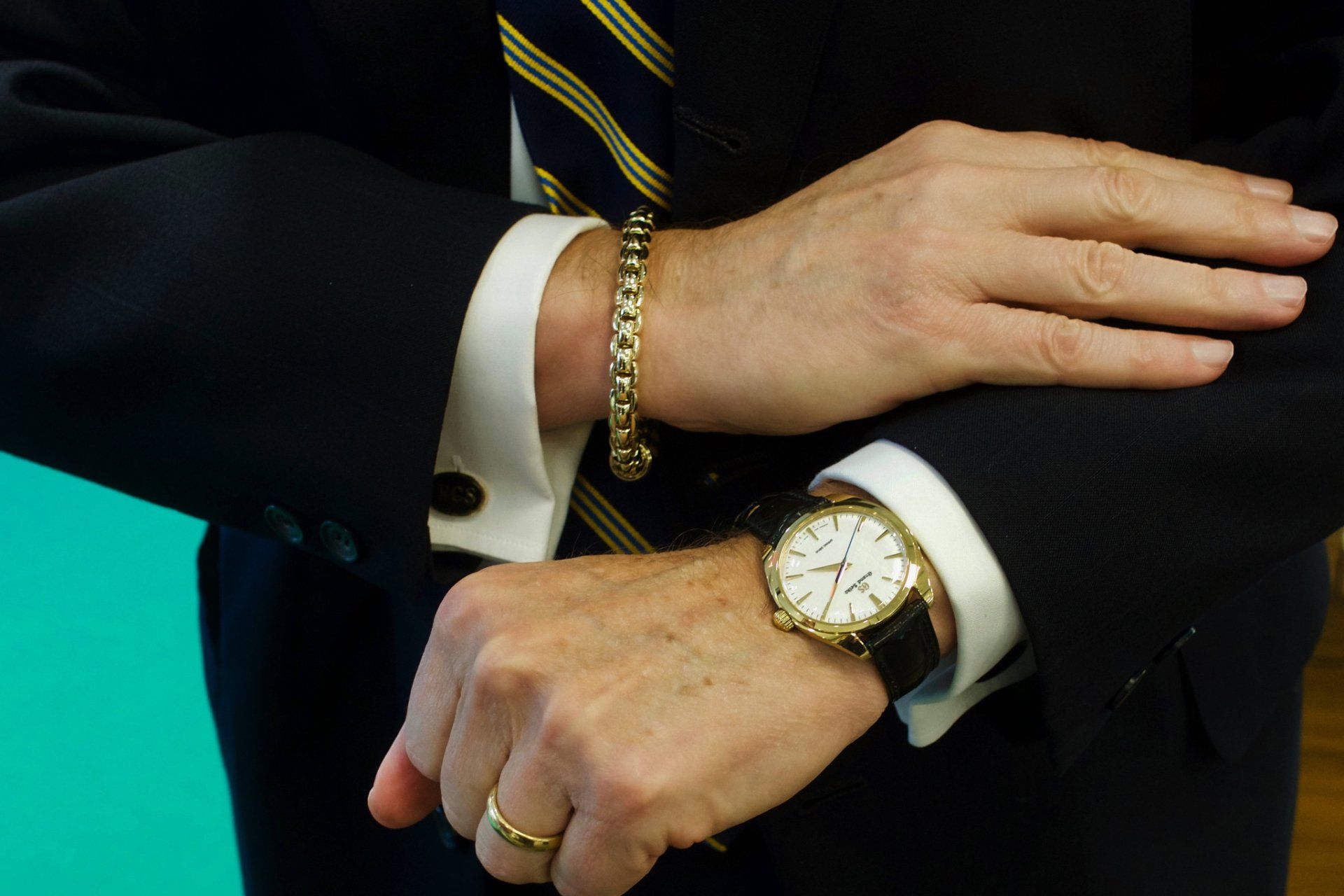18k GOLD Dress Watch STUNNER - Grand Seiko SBGY002 (pictured above with FOPE bracelet and Bitcoin Signet Ring)
The dial expresses a unique pattern inspired by the wind-swept snow in the mountains of Shinshu. The new manual-winding Spring Drive caliber, 9R31, has two mainsprings set in parallel within a single barrel, but still captures the signature glide motion seconds hand reflecting the natural and continuous flow of time, with the same high precision rate of one second a day and delivers a power reserve of 72 hours. Dual-curved sapphire, Anti-reflective coating on inner surface - Diameter 38.5mm × Thickness 10.2mm - Crocodile leather strap with Three-fold clasp with push button release. 9R31 movement with 72 hour power reserve.
Grand Seiko SBGY002 18k GOLD Spring Drive Dress Watch (above)
SBGA231 Spring Drive Diver (below)
Finally Mechanical Watch Perfection
Grand Seiko SBGA231 - A Spring Drive Powered Diver’s Watch + Snowflake SBGA211 - Perfect Combo Meal Deal!
Special Note:
May 9, 2019 I picked up the grand Seiko SBGN005 GMT - Click Here to learn more!
Special Note -
for those who don't want a diver's style watch I've included my review of the Grand Seiko Snowflake below. It's an amazing watch for everyday all purpose use. It's so comfortable on wrist you will forget you have it on. Also, the Snowflake looks great on the beach or in the boardroom. Looking for a stunning 18K GOLD dress watch? Scroll to the bottom of this page for the SBGX038 stunner!
A step up from the Rolex Submariner - Mine runs within 1 second a month!
Note: My Grand Seiko Snowflake is gaining about 2 seconds a month.
Paul Pluta aka ArchieLuxury referring to the Grand Seiko Spring Drive movement:
"The future of mechanical automatic movements...is so far ahead of the Swiss it's not funny."
Love videos?
CLICK HERE for my Grand Seiko YouTube playlist!
Also be sure to join the Grand Seiko flickr photo group
and share your epic GS photos: https://www.flickr.com/groups/grandseiko/
Special Note:
Need more money to buy watches? See my Take Control Downloads
page!
May 2018, Craig Shipp -
This diver’s watch is powered by Grand Seiko’s unique Spring Drive caliber mechanical self-winding movement with a three day power reserve. The case and band are made with a special high-intensity titanium alloy, providing superior scratch and corrosion resistance. The comfortable 137g weight (30% lighter than stainless steel) makes this diver a pleasure to wear 24/7/365. As a comparison the Rolex Submariner weighs 153g. The watch is water resistant to a depth of 200 meters and utilizes Lumi Brite for increased visibility of the brushed titanium hands and index. Designed for use in some of the most unforgiving environments, the rotating bezel is removable for simple maintenance while the area around the crown has been crafted to ensure that residue from dirt, sand, or seawater can be easily washed off. This watch also meets the ISO 6425 dive watch standards. With a mirror-finished case achieved through Zaratsu polishing, a lustrous rotating bezel, and multi-faceted cut indices, this watch is unmistakably Grand Seiko in its appearance, high specifications and durability.
By the way, as for long-term reliability and durability of the Spring Drive movement, Seiko says that because the entire gear train rotates constantly without several stops every moment, because there is no traditional escapement with sensitive, lubricated sections, and the rotor wheel of the gear train rotates continuously, Spring Drive movements should last you a very long time. As for the electronic parts, because there are no chemical components (e.g., a battery) to deteriorate and the way the electronics work are comparable to quartz movements (which can last several decades), one should expect an exceptionally long life from a Spring Drive watch. The movement can also withstand a much wider spectrum of temperatures than regular mechanical watches. Due to its design the Spring Drive is indeed robust and should outlast even the finest full mechanical movements.
Unofficial nickname for the SBGA231 coined by Sam Gray: Titan or Titanium Titan
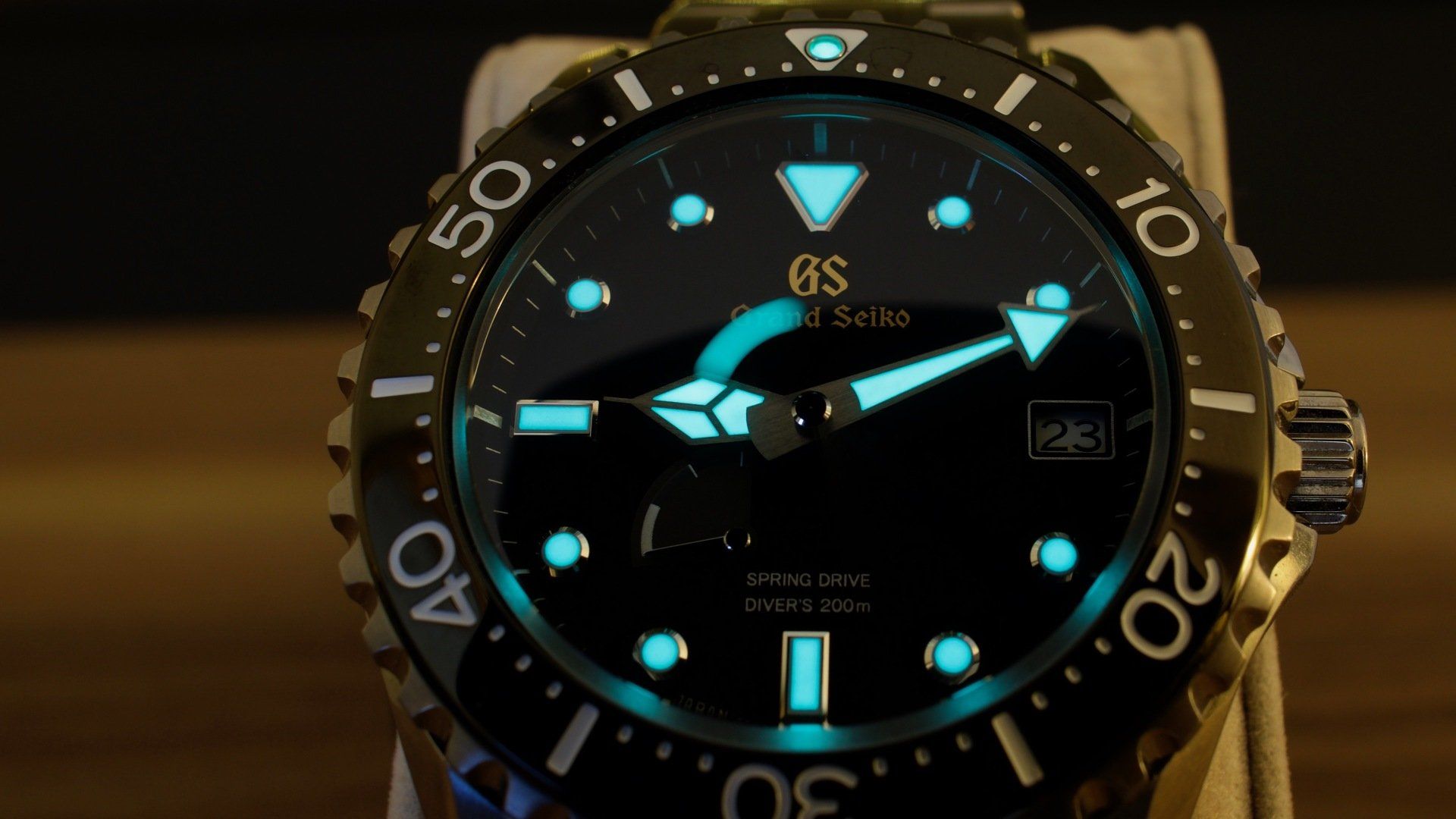
The ROLEX Submariner is no longer the king of the sport watches. The Grand Seiko SBGA231 Spring Drive diver watch in titanium is a better watch. The GS is more accurate, more comfortable on wrist, has better fit and finish and has a longer power reserve. Also, the Grand Seiko needs less service and the sweep second hand is amazing to watch. The more you wear the GS diver the more you notice the attention to detail that the in-house hand construction allows. The entire watch is hand-made by the folks at Grand Seiko. Extreme quality is the norm. Stop by and see the large selection of GS watches at http://littletreasury.com
- If you do, like me, you will leave with a new Grand Seiko on your wrist!
This watch meets the requirements of ISO 6425 – that’s the international standard for diver’s watches, which specifies, among other things, a unidirectional turning bezel, water resistance to a minimum of 100 meters, an ability to resist magnetic fields up to 4,800 A/m (60 gauss), and other standards for essential stuff like shock resistance, resistance to corrosion, and so on.
Many have asked why Seiko uses pins and friction collars or what they refer to as pins and pipes to hold links together in many of their high-end bracelets. This system allows for better movement of the bracelet in use and less wear on the links. Also, when compared to friction pins they hold up better used over and over again. When compared to screws the pins and pipes are less likely to come lose when properly installed. This system is one of the main reasons the GS bracelets are so comfortable and long lasting. Another advantage of the pins and collars is they are easily replaceable if they show any wear. It's also noteworthy that Patek Philippe uses a pin and collar system for many of their bracelets.
The diver clasp
- Many have made negative comments about the clasp on the SBGA231. When I first saw the clasp I was not impressed either. It's mostly stainless steel and portions are stamped. Not milled like a Rolex clasp. But after using the clasp for several weeks I came to realize this is a case of function trumping style. The clasp works so well in daily use that to me it's now one of my favorite aspects of the watch. The diver's extension is easy to use on wrist and allows for quick micro adjustments at anytime during the day. The clasp also has four micro adjustments for seasonal adjustments so an owner should only have to size the bracelet by removing links one time at the time of purchase. All around it's a functional and robust system that works with little effort. Two thumbs up for the clasp!
Grand Seiko SBGA231 stats:
Case:
High-intensity titanium Case back: Solid titanium - How durable is grade 5 titanium? Click Here!
Glass:
Sapphire crystal
Coating:
Anti-reflection coating on inner surface
Lumi Brite:
Hand and index
Case size:
Diameter 44.2mm × Thickness 14.0mm - 22mm lug width
Movement:
Caliber 9R65
Driving system:
Spring Drive
Power reserve:
Approximately 72 hours
Accuracy:
±1 per day (±15 seconds per month)
Clasp:
Three-fold clasp with push button release
Water resistance:
for air diving 200m
Magnetic resistance:
4800 A/m (60 gauss)
Weight:
137.0 g (Rolex Submariner Date 155g)
Remarks:
Screw down crown
Screw back
Jewels: 30
Power reserve display function
ISO 6425 certified dive watch
(tests shock, antimagnetic, legibility, waterproof and more).
The Grand Seiko Spring Drive system needs less service and the sweep second hand is amazing to watch. The more you wear the GS diver the more you notice the attention to detail that the in-house hand construction allows. The entire watch is hand-made by the folks at Grand Seiko. Extreme quality is the norm. Stop by and see the large selection of GS watches at http://littletreasury.com
- If you do, like me, you will leave with a new Grand Seiko on your wrist!
About the titanium used by GS: Is a Seiko proprietary alloy which is claimed to be 1.5 times harder than 316L stainless steel. Bright Titanium is used in the GS SBGA211 "Snowflake", SBGA231 200m diver, SBGC205 Spring Drive GMT chronograph, SBGE015 Spring Drive GMT and other models within the Seiko portfolio of premium brands. Special Note:
The SBGR305 was a limited edition model from 2017 and the first to use “Brilliant Hard Titanium” another alloy that's harder still at 2 times harder than typical stainless steel.
As I have been told my YSERV, Bright Titanium (aka "High intensity titanium") does not have any special surface coatings or additional treatments. Its scratch resistance is about 300-350 in the Vicker's scale. Compare that to 316L stainless steel (180-200) and pure titanium (Around 100).
The intent of the alloy is three fold:
To give the watch the sheen and look of a stainless steel finished piece, thus avoiding the "dull" and "plasticky" look often associated with pure titanium watches.
To give the watch increased wear resistance properties. Titanium is far stronger than stainless steel, has superior corrosion properties, is hypoallergenic, has about 50% the total density of stainless steel and it is more durable. However, titanium in its "pure" form is softer and tends to scratch much easier than steel.
To allow the metal to be refinished when the watch is sent into service. The presence of surface treatments and coatings (Like DiaShield or Citizen's Duratect) make the refinishing process more difficult, although, these coatings provide essentially higher wear resistance properties.
Bright Titanium is not to be confused with Seiko's DiaShield surface treatment which is a special surface coating applied to pure titanium and it is available in a very limited selection of affordable Seiko watches. DiaShield has surface wear resistance in the 500-600 range in the Vicker's scale. Citizen's Duratect is even better with surface wear resistance measured in the 800-1200 region in the Vicker's scale..
Stainless steel watches, have in my opinion, the edge in the overall looks department and the metal is easiest to restore. While Bright Titanium is close in terms of the "sheen" and appearance of stainless steel, is not in equal terms and it is not a substitute either.
One aspect that I don't like too much about titanium watches in general (Be it pure titanium, coated or Bright Titanium alloy) is the propensity of the surfaces to show finger prints and smudges. It is hard to keep a titanium watch free from these agents in comparison to a steel counterpart.
Bright Titanium has the advantage of preserving some of the look and feel of steel in a lighter package with all the inherited advantages of titanium. It can also be refinished, hence why Bright Titanium is offered in the Grand Seiko range but you will never find Grand Seikos or Credors with DiaShield, because the coating makes repairs more difficult (Egg shell effect if the coating is dinged up or severely damaged).
I think that Titanium treated surfaces are a double edged sword. They do provide effective daily wear protection but if severe damage is done to the surface, thus breaking the coating, repair will be difficult if not impossible.
The SBGA029G is the stainless steel version.
The SBGA031 is the older titanium model with SEIKO on the top of the face.
The Grand Seiko Quartz Diver are models: SBGX115 SBGX117
Hear what some experts from the forums.watchuseek.com
website have to say about the Spring Drive:
Alysandir,
"The thing to understand about Spring Drive is that it is a mechanical watch in every way except one: the escapement in a traditional mechanical has been replaced by the flywheel assembly, which includes the coils and the tri-synchro regulator (TSR). And the reason I make this point is to drive home the fact that the Spring Drive can be completely disassembled, just like a mechanical, including all elements of the flywheel assembly. The coils go bad? They get replaced. The TSR goes bad? Replaced. Don't think of Spring Drive like a monolithic quartz movement where if the IC goes, it's time to trash the watch. Grand Seiko goes on tours where they visit ADs and disassemble & reassemble a Spring Drive right in front of you; I've seen it first-hand and it's quite interesting."
Tseg
"There is an argument that the stresses to the mechanical components of a Spring Drive are less than that of an automatic watch. We also know Grand Seiko boasts a 50 year service interval for their quartz watches. Other than pressure testing a watch every year or so, I would think it reasonable to assume a Spring Drive can go 15-20 years before parts wear enough to affect time keeping. To put in perspective, I believe a typical quality mechanical watch can go 10 years before parts wear accelerates. I also believe in not servicing a watch until time keeping is visibly affected vs. the norm for that watch. Other than seal failure, catastrophic watch failures just don't occur from worn parts... and replacement of key worn parts generally is included in the service costs. Water in a watch and watch impact are the typical causes for exorbitant service costs.
I've seen service centers of quality watch brands make nearly destroyed watches like new again. As long as parts are available just about any watch, no matter the service interval, can be made like new again. Seals and water are the issue. I've been eying up a 10 Bar pressure tester... but at $1250 have not yet brought myself to pull the trigger."
mpalmer
"I think there is no question that Grand Seikos can be serviced and kept for generations. The real question is how many/which owners will care to do so. The watches will certainly be serviceable long into the future; I think the real question is how long into the 'future' owners will elect to pay to service them. Will a Grand Seiko be practical to keep servicing for the rest of your liftime? Certainly, as long as you still like the look of it in 20 or 30 or 40 years more than your other options. Realistically, in 40 years, a new 1k watch in today's money might well be look nicer than a 40 year old Grand Seiko to many non WIS and might make the servicing cost more questionable, but then again not to others (i.e. WIS vintage collectors), so this is clearly subjective and it depends on who owns the watch down the line. Will your children or grand children or whomever they have given/sold the watch to want to service the watch 50+ years from now? It is hard to say. My guess is it may depend largely on sentimental value or on the cash value of the watch. I still think that if you really want to improve the chances a watch will still be serviced by the owner for the very long term, the best bet is significant cash value, i.e. a 30, 40, or 50 year old Patek will likely still be serviced because it is still in the financial interest of the owner to do so, irrespective of their WIS/non-WIS status, because of the value of the watch.
Ultimately, I don't worry about ownership beyond my own, I just wear watches. Nothing lasts forever, and I don't see any need to convince myself my watches will be worn decades after I am not around to enjoy them. If my children/grandchildren or whomever they gift or sell them to enjoy them enough they will be worn, if not, they will end up in a box or at a flea market. What I have become more aware of and consider much more now is the long term practicality of servicing the watches I buy during my ownership of the watches. This is why I have reduced the number of watches that I own and will likely keep the number relatively small, and have/will in the future gravitate toward a smaller number of higher end watches. For me, less watches mean lower servicing costs, less inefficiency, and moving toward higher end watches will lead to less/slowed acquisitions, less flipping, and longer term practical ownership of my watches (I'll be less likely to feel the need to flip them for something else or question if I should stop servicing them when they get older).
If one really is concerned about having to own a watch that is likely to be worn by someone many decades from now, I think that the long term likelihood of a high cash value of the watch is probably going to be the best predictor of voluntary servicing over the very long haul, and this is likely to be at least somewhat influenced by the current cost of the watch."
Samuel Chan:
In response to my question: It seems like to me that the auto winding on the GS Spring Drive movements is so efficient that they stay fully wound most of the time. Do you know if there is any downside to a Spring Drive staying fully wound most of the time? Is it a good idea to let them run down from time to time? Samuel's answer:
Craig, since you are switching between the two watches everyday, I don’t see a reason to let either wind down. You should let it wind down only if you are not using the watch. The beauty about the SD is the efficiency of the power delivery. The “torque” needed to drive (the “drive” in spring drive) the mechanism is lower than that of a traditional mechanical watch. A SD puts less forces on the going train because it only needs to unwind at c.1.5:1, where as a traditional mechanical 4hz movement is usually 10:1, hence requiring a less “powerful” mainspring. That means that the counter-forces required to wind the mainspring is far lower, hence explaining why it is so easy to keep the PR up. Hope this explanation helps.
Domo,
"I don't understand how a SD movement can break. The winding is the familiar magic lever which never effs up and everything that turns only spins in one direction, and there's nothing that can be knocked out of adjustment because nothing is fine-tuned (mechanically) inside the movement. I think the SD will turn out in the long run to be a really enduring design. Even the elements that "mesh" to regulate the watch do so without actually touching each other. The only other mechanical contact points is the gear train to drive the hands, not much to go wrong there..." see: https://forums.watchuseek.com/f21/spring-drive-service-interval-1639786.html
Learn more at:
littletreasury.com/product/grand-seiko-sbga231 (ask for Steve and they will ship watches out of the area)
From another Spring Drive owner - Re: Grand Seiko Diver - Quartz or Spring Drive
I have a spring drive chrono and I don't plan on maintaining it until it actually has a problem. I'll take my chances. In my experience with all kinds of products the product is never the same after they crack the original seal with any manufacturer warrantees or service. I had Seiko fix a watch under warranty that was 10 bar rated and it ended up taking on water. They had to give me a new one. I've had new cars that when I took them in for warranty at the original dealer; more than once it came back with new problems. I like having the factory seal on my SD. At this point it's un-contaminated.
I honestly don't feel comfortable having the seal broken for any reason; not a battery, service or warranty. I'll take my chances with the original assembly and seal. I believe the watch is the best it'll ever be mechanically. Every time you open it you invite unintended potential problems.
Discussing what might go wrong if I don't maintain it; what could go wrong? At 10 bar rated pressure seal, the oil won't be going anywhere. As far as wear, it is minimal. The gear train on the SD only moves in one direction. This reduces wear significantly. But even if over a very long period of time it does experience wear then it'll probably start to run a little faster. This wouldn't or shouldn't be a problem because the SD electromagnetic braking system will slow it down to match the quartz timing mechanism inside so that it still maintains a 1 minute a year accuracy. Lets say I get 35 years out of it before I have to service it. So what? I avoided 6 service intervals at savings of about $4800 dollars. I'll just buy a used one from someone that did maintain it or I'll spend $1500 to fix whatever happened to it and go another 35 years.
I've heard, but not sure if this is true, that some watch collectors of old watches actually prize an old watch with an original factory seal; don't know if it is true or not. As far as durability, you may want to watch this video of the testing that Seiko went through with Cal Poly State University to see if the SD would hold up in space before they produced the Spacewalk Spring Drive. It's pretty impressive.
To learn more about the amazing Spring Drive movement see:
Below is my look at the Grand Seiko Snowflake SBGA211
Grand Seiko Snowflake - SBGA211 stats:
Case:
High-intensity titanium with dual curved sapphire crystal with anti-reflective coating on inside and display back
Size:
Diameter 41mm x 12.5mm thick - 20mm lug width
Movement:
9R65 Spring Drive with 72 hour power reserve
Weight:
100 grams
Water resistance:
100m (screw down crown)
Magnetic resistance:
4800 A/m (60 gauss)
The following is reprinted from a detailed Spring Drive article by the watch experts at HODINKEE
The current generated goes to an integrated circuit and quartz crystal, which vibrates as the current passes through it, and the IC counts the oscillations. However, rather than dividing by two until a one second interval is counted off, and then sending a signal to a stepper motor, the IC passes energy back to the electromagnets surrounding the glide wheel. Here electrical energy becomes magnetic force, and this exerts a braking energy on the glide wheel; the amount of electrical energy fed back is precisely controlled so that the glide wheel turns eight times a second exactly. Thus, the glide wheel ensures that the mainspring unwinds in a controlled fashion, in the same way that the escape wheel, lever, and balance (and balance spring) of a conventional watch control the rate at which the mainspring unwinds.
In essence, therefore, Spring Drive movements are mechanical, but with an electromagnetic escapement regulated by a quartz oscillator. One of the reasons development of Spring Drive took so long, is because the amount of energy generated is extremely tiny. To be usable in a commercial watch, it was necessary to develop a special low-energy-consumption integrated circuit, and as well, the coils had to be wound with very thin copper wire, in order to ensure the maximum number of turns around the coil itself. For this purpose, a special type of wire was developed with an hexagonal cross section, allowing the coils to be wound with no gaps – not even microscopic ones – between the turns of the wire, which means greater total length in a given volume. You can actually see the difference between the coils used for Seiko Kinetic watches (which have batteries charged by a mechanical rotor) and Spring Drive coils with the naked eye; during our recent trip to Shiojiri we were able to photograph the two coils side by side.
The amount of electrical energy generated is extremely minute; one way of visualizing it is to imagine everyone on Earth wearing a Spring Drive watch. Were this to be the case, the resulting electrical energy would be just barely enough to light one 100 watt light bulb. In order to have an acceptable power reserve, the entire system has to work extremely efficiently, which is why it was necessary to develop a new coil system, as well as the high efficiency integrated circuit. The mechanical train has to be manufactured and assembled to a very high degree of precision as well, in order to reduce frictional losses to an absolute minimum (this is an easy thing to miss about Spring Drive but for them to work, they have to be high precision mechanical watches as well as advanced technology platforms).
The question is often asked, "isn't Spring Drive a quartz watch?" It's not, at least not in the sense we usually think of quartz watches. The electromechanical drive system in Spring Drive is regulated by a quartz crystal, yes; however, there are so many fundamental differences between Spring Drive and quartz watches as a class, that it really is a different technology. Ultimately, Spring Drive isn't really a mechanical watch in the ordinary sense of the word, but it's not a quartz watch either – it's Spring Drive.
See the full article at: https://www.hodinkee.com/articles/grand-seiko-spring-drive-snowflake-review
Here's a breakdown of the Grand Seiko models numbers:
Everything begins with SBG (for men's watches; ladies' are STG)
A is a 3 hand spring drive
E is a GMT spring drive
C is a spring drive chronograph
H is a hi-beat
J is hi-beat GMT
T, X, V are various quartz models etc.
J after the model number denotes Japan only but some of those pieces may be migrating to the American market.
To learn about all the amazing Grand Seiko watches visit:
(ask for Steve and they will ship watches out of the area if you can't make it to the showroom)
Beautiful Grand Seiko SBGX038 dress watch in 18k gold - Great affordable dress watch!
It's a 9F quartz movement so it's great for occasional use. See video of my first look below.
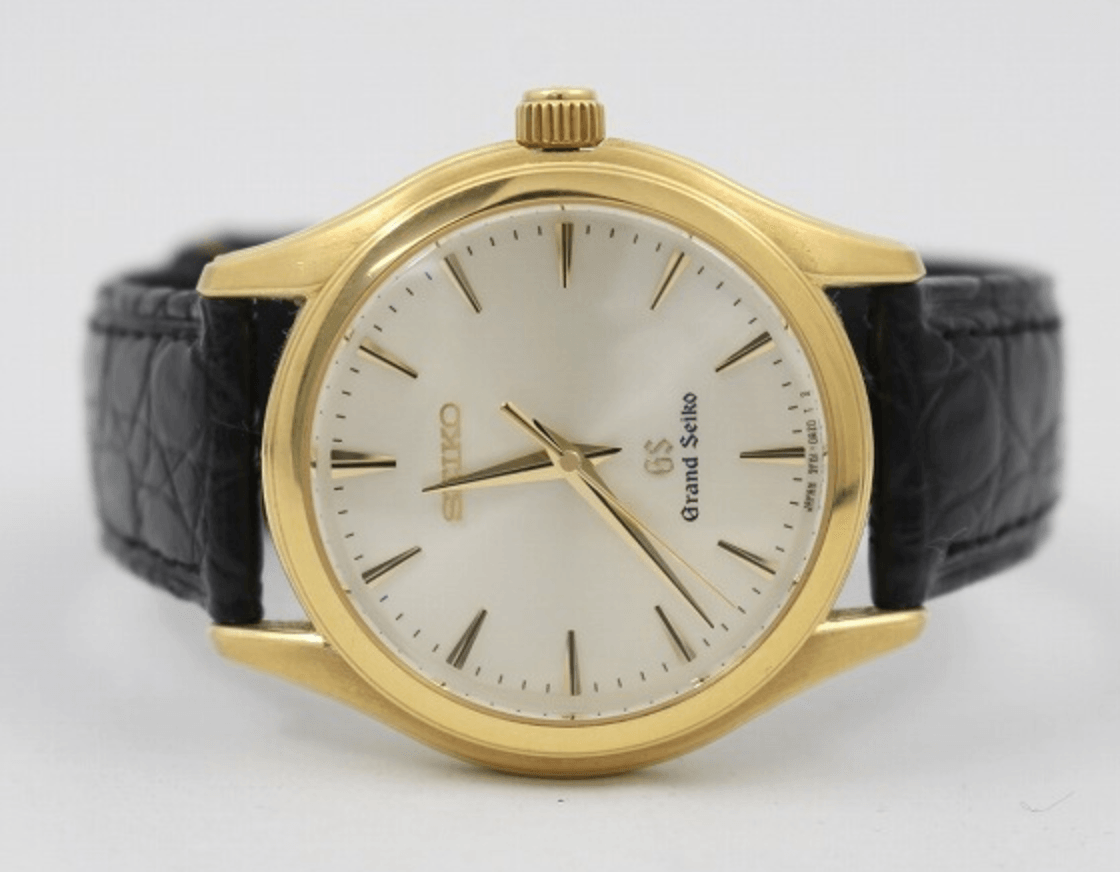
Dateline May 9, 2019
- I visited Little Treasury Jewelers
and picked up this stunning Grand Seiko SBGN005 GMT.
This could just be the perfect all around travel and do anything watch. Click Here
for my first video discussing this beauty.
SBGN005 GMT Stats: Case width 39mm; 12.1mm thick; Lug width 19mm; Weight 135g - other models: SBGN003; SBGN001
Below is my FOPE 18K yellow gold bracelet. It complements the Grand Seiko SBGY002 nicely.
Paul Pluta AKA - ARCHIELUXURY - PERFECT 2 PIECE WATCH COMBO:
Rolex President and Grand Seiko SBGA231 - see: https://youtu.be/Zwi5fTvCrGs
Looking for a really cool facebook watch group? Checkout WATCHA!
While you're at it also visit the Grand Seiko Owners Club!
Click Here for some high-end clothing brands to complement your watch!
Watch dial sizes: As a reference a USA quarter is 25.4mm: Rolex DATEJUST 36 is 28mm;
Rolex Submariner 40 is 29.5mm; The Rolex Explorer 39mm has a 31mm dial;
My 35mm SBGX 18k GS is 28mm; My SBGA231 GS diver 32mm
Also checkout my flickr photos!



